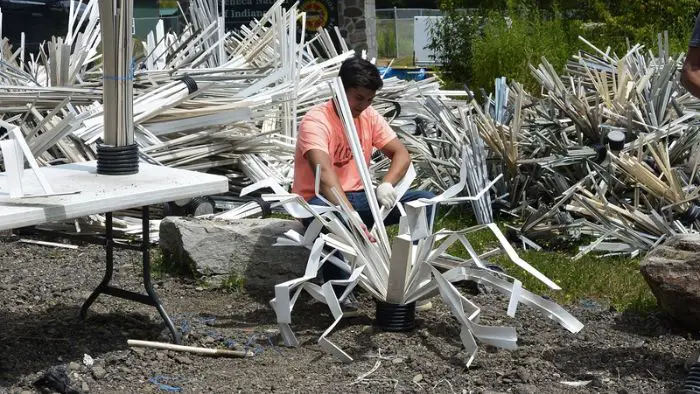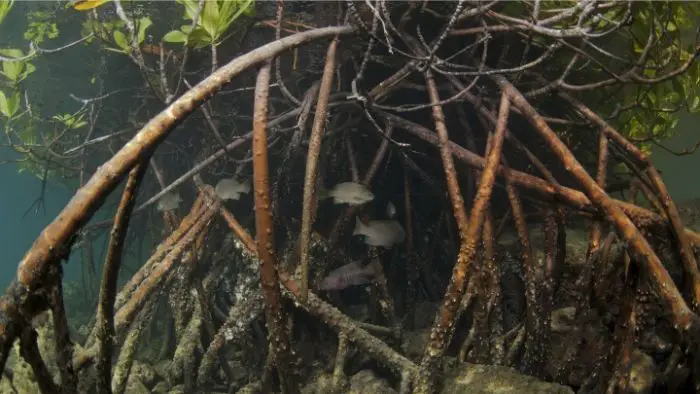Explore your options for building a homemade fish habitat.
There are no species of fish that do not like to have their own hiding place. Bass, crappie, bream, and catfish simply enjoy some kind of cover, such as log, brush, stump, or different types of weeds. Good, homemade fish habitat will provide your aquatic pets with hiding places, but let’s not forget the areas for growing algae, plankton, and other food sources either.
Building a homemade fish habitat, structure, and/or attractors is a great idea for any fish enthusiast. Of course, there is some effort, time and planning involved. However, when you add up all the benefits, all the effort really pays off when you see that your pets enjoy your hard work. So as not to procrastinate too much, let’s get to the point.
Artificial Fish Habitats
Artificial fish habitats are one of the easiest and at the same time the cleanest methods to provide your fish pets with a safe home. You will not be deceived if you say that this type of homemade fish habitat is sometimes more productive than those offered by Mother Nature herself.
In the case of artificial types, the positive side is that they do not disintegrate so easily, and among other things, they do not add mud to the bottom. For all those who plan to create a homemade fish habitat for recreational fishing, they will definitely like the fact that such habitats are designed to prevent hooks from snagging while giving the fish time to fall hook, line, and sinker for bait.
Furthermore, we must note that on average one fish habitat has at least 9 trees and 12 shrubs per acre. This is an ideal number, but it also varies and depends on the age of the pond and the species of fish.

Types Of Artificial Fish Habitat
When it comes to building a homemade fish habitat, owners usually opt for some of the following options:
Hole Trees: These options are a great choice for depths up to 6 feet or more, and in addition, they generally provide up to 15,000 square inches of surface area for algae and eggs to attach.
Hole Shrubs: These on the other hand are an ideal option for shallower depths. Don’t be fooled, because they, although intended for such depth, provide a large area for your fish to enjoy.
Fish Attractor Spheres: Truth be told this is one of the best homemade fish habitat options as it is made of PVC cement as well as cleaners, which actually means you can make as many as you want.
Spawning Discs: This is another interesting option to enrich your homemade fish habitat, as it increases hatching rates by providing a stable and solid surface for fish to lay eggs.
Natural Fish Habitats
If you prefer to make a homemade fish habitat that is more natural in nature, we suggest you use a combination of rocks, plants, trees, and logs. Read more about each of them below.
Types Of Natural Fish Habitats

Rocks
Boulders or cinder blocks are one of the best yet natural ways to introduce a place for your fishes to hide. They can act as attractors for various fish species, and among other things, they also provide a medium for the growth and development of beneficial bacteria and string algae. Another positive feature of rocks is that they can be used to break fast-moving currents and provide a resting place for fish.
Plants
Plants are the most natural type of homemade fish habitat, as they not only provide shelter, block sunlight, and help prevent erosion but also enrich the water with oxygen. There are many species to choose from (submerged, floating, and emergent) however stick to those native to your area. Otherwise, you can introduce an invasive specimen that can ruin years of your hard work in just a few hours.
Be sure to keep them under control, use plant bags or baskets to set boundaries, prune them regularly, and don’t forget to remove all those dead plants.
Trees & Logs
Logs, and in some cases even whole trees, can be used as fish habitats, just be careful to weigh them down so they can sink into the water. Lastly, keep in mind that this is a natural material that will eventually begin to decompose and form mud. All in all, this should not be a problem as you can proactively remove decomposing material to reduce dirt.

Click here to find out more.
Abstract
That would be it, now you know what your options are if you want to build a homemade fish habitat. Have you ever created your own fish habitat and what materials did you use the most? Write us your answers in the section below. We look forward to reading.
Take a look at this article as well: The Secret To Raising Freshwater Prawns In Tanks
FAQ’s
How Do You Build A Fish Structure?
There are two basic guidelines that should be followed if you want to build a good fish structure. The first one is to build upon the structural characteristics of the place where you want to build it, and the second one is to use everything you already have with various moderations and improvements.
What Is An Artificial Fish Habitat?
Unlike natural materials such as stones, plants, various trees, and logs, the artificial habitat is mostly made of plastic, but the purpose is the same, to protect fish and allow them to reproduce.
What Can I Use For A Fish Habitat?
The materials you use depend on your preferences as well as your budget. Furthermore, most owners generally choose to make a fish habitat out of some natural materials such as rocks, plants, trees, and logs.
However, you shouldn't limit yourself to that, a good part of them decide to use what they already have at home and accordingly use recycled Christmas trees, buckets, PVC pipes, and spider blocks.
What Is The Fish Habitat?
The fish habitat provides your pets with a place to hide, but also a place to grow algae.
